service BMW X5 4.8IS 2004 E53 User Guide
[x] Cancel search | Manufacturer: BMW, Model Year: 2004, Model line: X5 4.8IS, Model: BMW X5 4.8IS 2004 E53Pages: 200, PDF Size: 3.91 MB
Page 27 of 200
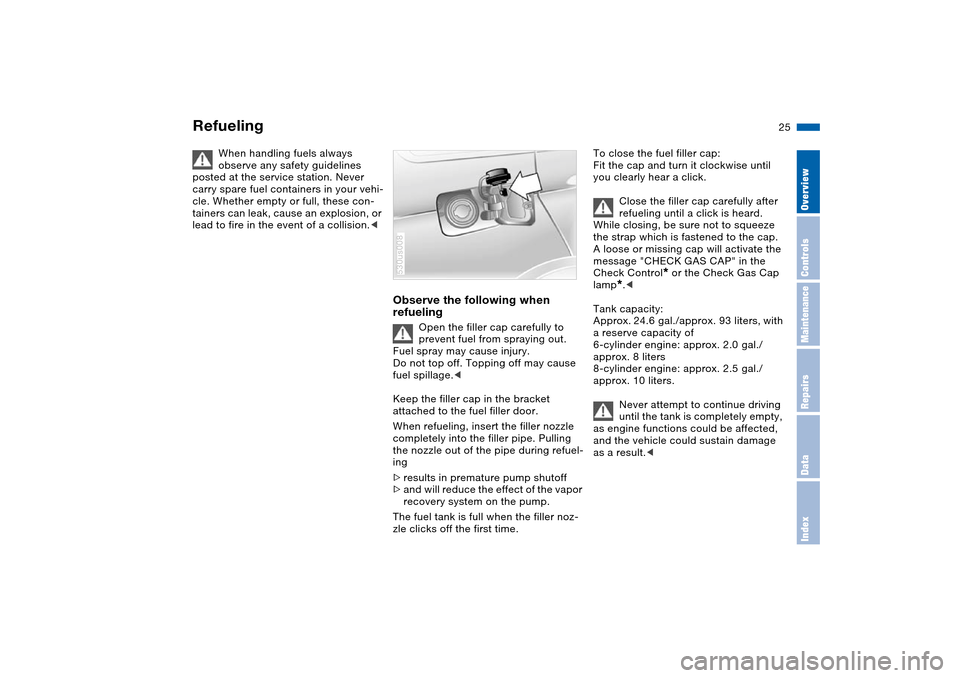
25n
OverviewControlsMaintenanceRepairsDataIndex
Refueling
When handling fuels always
observe any safety guidelines
posted at the service station. Never
carry spare fuel containers in your vehi-
cle. Whether empty or full, these con-
tainers can leak, cause an explosion, or
lead to fire in the event of a collision.<
Observe the following when
refueling
Open the filler cap carefully to
prevent fuel from spraying out.
Fuel spray may cause injury.
Do not top off. Topping off may cause
fuel spillage.<
Keep the filler cap in the bracket
attached to the fuel filler door.
When refueling, insert the filler nozzle
completely into the filler pipe. Pulling
the nozzle out of the pipe during refuel-
ing
>results in premature pump shutoff
>and will reduce the effect of the vapor
recovery system on the pump.
The fuel tank is full when the filler noz-
zle clicks off the first time.
530us008
To close the fuel filler cap:
Fit the cap and turn it clockwise until
you clearly hear a click.
Close the filler cap carefully after
refueling until a click is heard.
While closing, be sure not to squeeze
the strap which is fastened to the cap.
A loose or missing cap will activate the
message "CHECK GAS CAP" in the
Check Control
* or the Check Gas Cap
lamp
*.<
Tank capacity:
Approx. 24.6 gal./approx. 93 liters, with
a reserve capacity of
6-cylinder engine: approx. 2.0 gal./
approx. 8 liters
8-cylinder engine: approx. 2.5 gal./
approx. 10 liters.
Never attempt to continue driving
until the tank is completely empty,
as engine functions could be affected,
and the vehicle could sustain damage
as a result.<
Page 31 of 200
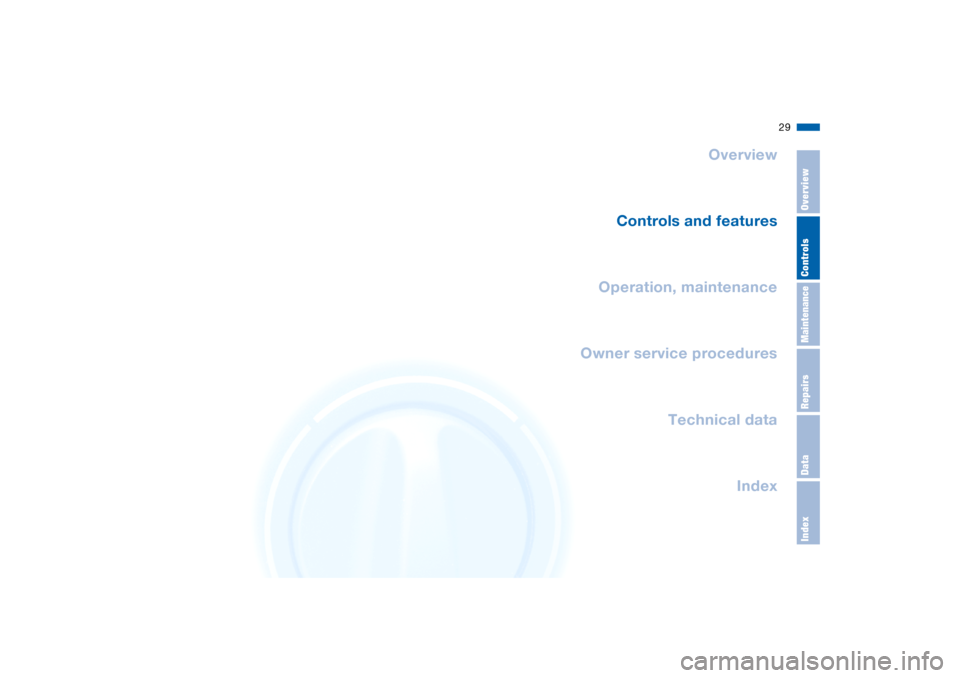
MaintenanceOverviewControlsRepairsDataIndex
29n
Overview
Controls and features
Operation, maintenance
Index Technical data
Owner service procedures
Page 59 of 200
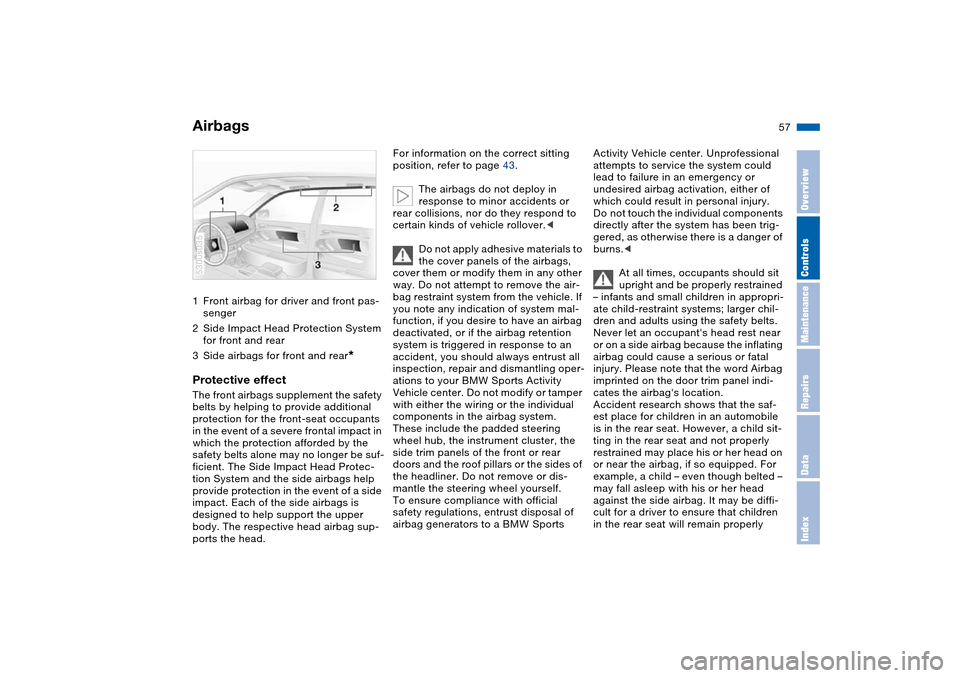
57n
OverviewControlsMaintenanceRepairsDataIndex
Airbags1Front airbag for driver and front pas-
senger
2Side Impact Head Protection System
for front and rear
3Side airbags for front and rear
*
Protective effect The front airbags supplement the safety
belts by helping to provide additional
protection for the front-seat occupants
in the event of a severe frontal impact in
which the protection afforded by the
safety belts alone may no longer be suf-
ficient. The Side Impact Head Protec-
tion System and the side airbags help
provide protection in the event of a side
impact. Each of the side airbags is
designed to help support the upper
body. The respective head airbag sup-
ports the head.530us035
For information on the correct sitting
position, refer to page 43.
The airbags do not deploy in
response to minor accidents or
rear collisions, nor do they respond to
certain kinds of vehicle rollover.<
Do not apply adhesive materials to
the cover panels of the airbags,
cover them or modify them in any other
way. Do not attempt to remove the air-
bag restraint system from the vehicle. If
you note any indication of system mal-
function, if you desire to have an airbag
deactivated, or if the airbag retention
system is triggered in response to an
accident, you should always entrust all
inspection, repair and dismantling oper-
ations to your BMW Sports Activity
Vehicle center. Do not modify or tamper
with either the wiring or the individual
components in the airbag system.
These include the padded steering
wheel hub, the instrument cluster, the
side trim panels of the front or rear
doors and the roof pillars or the sides of
the headliner. Do not remove or dis-
mantle the steering wheel yourself.
To ensure compliance with official
safety regulations, entrust disposal of
airbag generators to a BMW Sports
Activity Vehicle center. Unprofessional
attempts to service the system could
lead to failure in an emergency or
undesired airbag activation, either of
which could result in personal injury.
Do not touch the individual components
directly after the system has been trig-
gered, as otherwise there is a danger of
burns.<
At all times, occupants should sit
upright and be properly restrained
– infants and small children in appropri-
ate child-restraint systems; larger chil-
dren and adults using the safety belts.
Never let an occupant's head rest near
or on a side airbag because the inflating
airbag could cause a serious or fatal
injury. Please note that the word Airbag
imprinted on the door trim panel indi-
cates the airbag's location.
Accident research shows that the saf-
est place for children in an automobile
is in the rear seat. However, a child sit-
ting in the rear seat and not properly
restrained may place his or her head on
or near the airbag, if so equipped. For
example, a child – even though belted –
may fall asleep with his or her head
against the side airbag. It may be diffi-
cult for a driver to ensure that children
in the rear seat will remain properly
Page 67 of 200
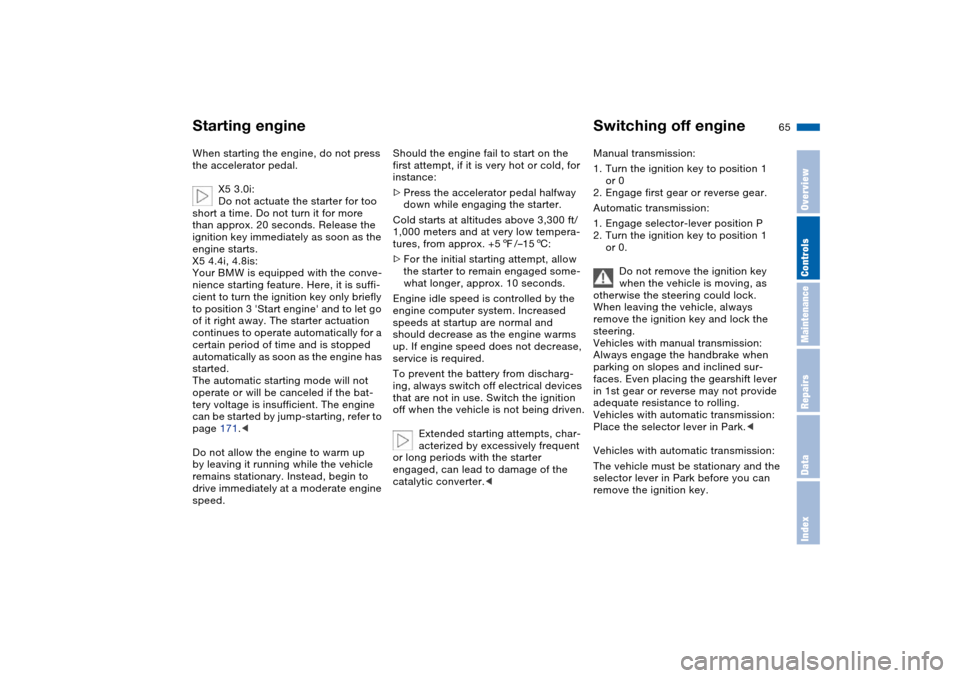
65n
OverviewControlsMaintenanceRepairsDataIndex
Starting engine Switching off engineWhen starting the engine, do not press
the accelerator pedal.
X5 3.0i:
Do not actuate the starter for too
short a time. Do not turn it for more
than approx. 20 seconds. Release the
ignition key immediately as soon as the
engine starts.
X5 4.4i, 4.8is:
Your BMW is equipped with the conve-
nience starting feature. Here, it is suffi-
cient to turn the ignition key only briefly
to position 3 'Start engine' and to let go
of it right away. The starter actuation
continues to operate automatically for a
certain period of time and is stopped
automatically as soon as the engine has
started.
The automatic starting mode will not
operate or will be canceled if the bat-
tery voltage is insufficient. The engine
can be started by jump-starting, refer to
page 171.<
Do not allow the engine to warm up
by leaving it running while the vehicle
remains stationary. Instead, begin to
drive immediately at a moderate engine
speed.
Should the engine fail to start on the
first attempt, if it is very hot or cold, for
instance:
>Press the accelerator pedal halfway
down while engaging the starter.
Cold starts at altitudes above 3,300 ft/
1,000 meters and at very low tempera-
tures, from approx. +57/–156:
>For the initial starting attempt, allow
the starter to remain engaged some-
what longer, approx. 10 seconds.
Engine idle speed is controlled by the
engine computer system. Increased
speeds at startup are normal and
should decrease as the engine warms
up. If engine speed does not decrease,
service is required.
To prevent the battery from discharg-
ing, always switch off electrical devices
that are not in use. Switch the ignition
off when the vehicle is not being driven.
Extended starting attempts, char-
acterized by excessively frequent
or long periods with the starter
engaged, can lead to damage of the
catalytic converter.<
Manual transmission:
1. Turn the ignition key to position 1
or 0
2. Engage first gear or reverse gear.
Automatic transmission:
1. Engage selector-lever position P
2. Turn the ignition key to position 1
or 0.
Do not remove the ignition key
when the vehicle is moving, as
otherwise the steering could lock.
When leaving the vehicle, always
remove the ignition key and lock the
steering.
Vehicles with manual transmission:
Always engage the handbrake when
parking on slopes and inclined sur-
faces. Even placing the gearshift lever
in 1st gear or reverse may not provide
adequate resistance to rolling.
Vehicles with automatic transmission:
Place the selector lever in Park.<
Vehicles with automatic transmission:
The vehicle must be stationary and the
selector lever in Park before you can
remove the ignition key.
Page 80 of 200
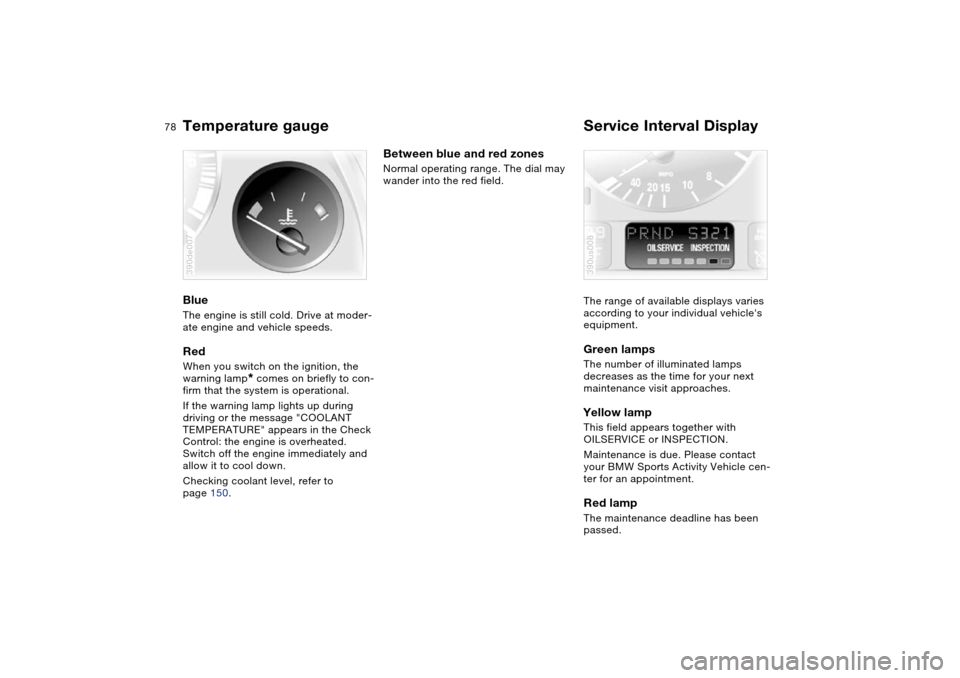
78n
Temperature gauge Service Interval Display Blue The engine is still cold. Drive at moder-
ate engine and vehicle speeds.Red When you switch on the ignition, the
warning lamp
* comes on briefly to con-
firm that the system is operational.
If the warning lamp lights up during
driving or the message "COOLANT
TEMPERATURE" appears in the Check
Control: the engine is overheated.
Switch off the engine immediately and
allow it to cool down.
Checking coolant level, refer to
page 150.
390de007
Between blue and red zones Normal operating range. The dial may
wander into the red field.
The range of available displays varies
according to your individual vehicle's
equipment.
Green lamps The number of illuminated lamps
decreases as the time for your next
maintenance visit approaches.Yellow lamp This field appears together with
OILSERVICE or INSPECTION.
Maintenance is due. Please contact
your BMW Sports Activity Vehicle cen-
ter for an appointment.Red lamp The maintenance deadline has been
passed.390us008
Page 96 of 200
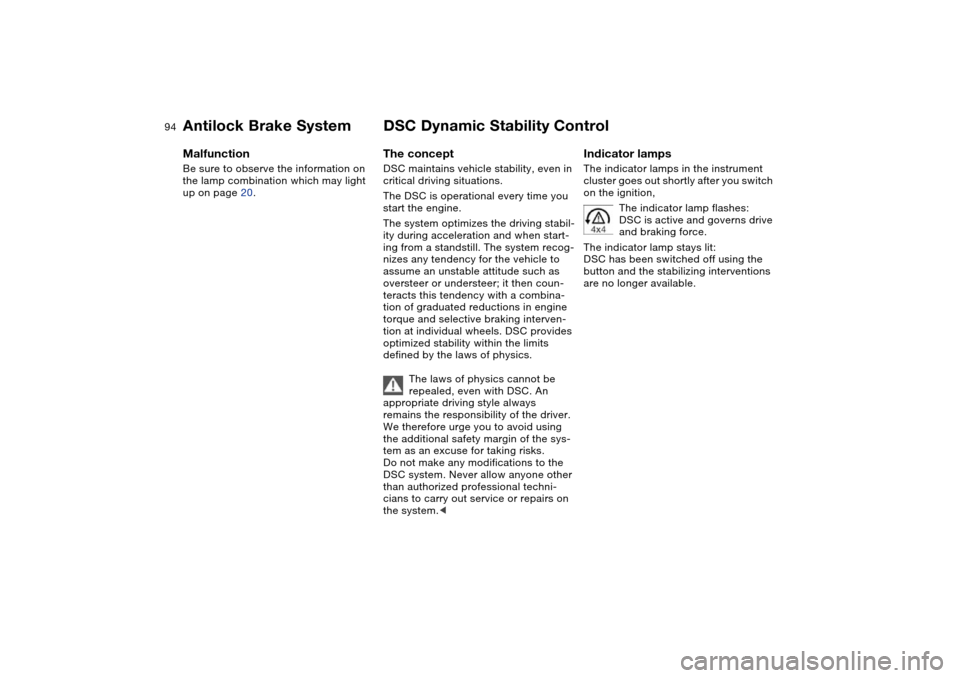
94n
Antilock Brake System DSC Dynamic Stability Control MalfunctionBe sure to observe the information on
the lamp combination which may light
up on page 20.
The concept DSC maintains vehicle stability, even in
critical driving situations.
The DSC is operational every time you
start the engine.
The system optimizes the driving stabil-
ity during acceleration and when start-
ing from a standstill. The system recog-
nizes any tendency for the vehicle to
assume an unstable attitude such as
oversteer or understeer; it then coun-
teracts this tendency with a combina-
tion of graduated reductions in engine
torque and selective braking interven-
tion at individual wheels. DSC provides
optimized stability within the limits
defined by the laws of physics.
The laws of physics cannot be
repealed, even with DSC. An
appropriate driving style always
remains the responsibility of the driver.
We therefore urge you to avoid using
the additional safety margin of the sys-
tem as an excuse for taking risks.
Do not make any modifications to the
DSC system. Never allow anyone other
than authorized professional techni-
cians to carry out service or repairs on
the system.<
Indicator lamps The indicator lamps in the instrument
cluster goes out shortly after you switch
on the ignition,
The indicator lamp flashes:
DSC is active and governs drive
and braking force.
The indicator lamp stays lit:
DSC has been switched off using the
button and the stabilizing interventions
are no longer available.
Page 137 of 200
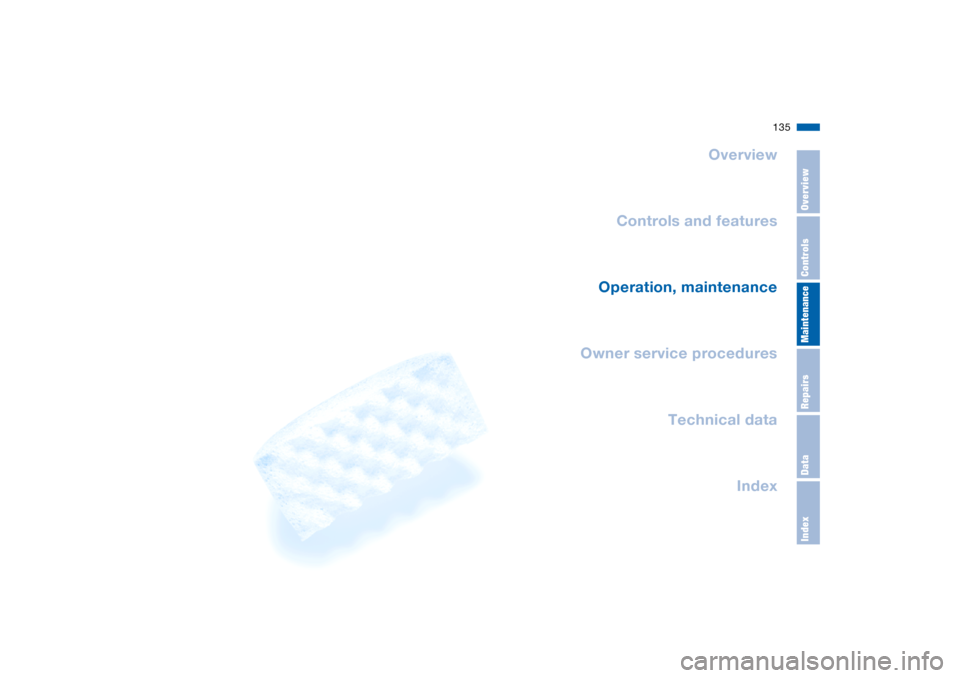
135n
OverviewControlsMaintenanceRepairsDataIndex
Overview
Controls and features
Operation, maintenance
Owner service procedures
Index Technical data
Mainte-
Page 138 of 200
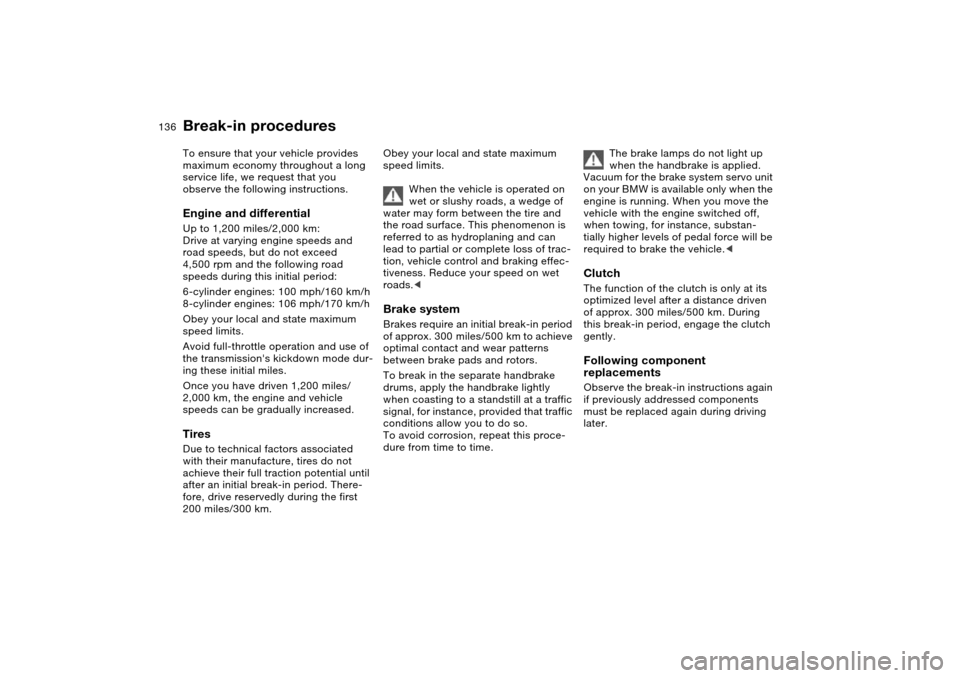
136n
To ensure that your vehicle provides
maximum economy throughout a long
service life, we request that you
observe the following instructions.
Engine and differential Up to 1,200 miles/2,000 km:
Drive at varying engine speeds and
road speeds, but do not exceed
4,500 rpm and the following road
speeds during this initial period:
6-cylinder engines: 100 mph/160 km/h
8-cylinder engines: 106 mph/170 km/h
Obey your local and state maximum
speed limits.
Avoid full-throttle operation and use of
the transmission's kickdown mode dur-
ing these initial miles.
Once you have driven 1,200 miles/
2,000 km, the engine and vehicle
speeds can be gradually increased.Tires Due to technical factors associated
with their manufacture, tires do not
achieve their full traction potential until
after an initial break-in period. There-
fore, drive reservedly during the first
200 miles/300 km. Obey your local and state maximum
speed limits.
When the vehicle is operated on
wet or slushy roads, a wedge of
water may form between the tire and
the road surface. This phenomenon is
referred to as hydroplaning and can
lead to partial or complete loss of trac-
tion, vehicle control and braking effec-
tiveness. Reduce your speed on wet
roads.<
Brake system Brakes require an initial break-in period
of approx. 300 miles/500 km to achieve
optimal contact and wear patterns
between brake pads and rotors.
To break in the separate handbrake
drums, apply the handbrake lightly
when coasting to a standstill at a traffic
signal, for instance, provided that traffic
conditions allow you to do so.
To avoid corrosion, repeat this proce-
dure from time to time.
The brake lamps do not light up
when the handbrake is applied.
Vacuum for the brake system servo unit
on your BMW is available only when the
engine is running. When you move the
vehicle with the engine switched off,
when towing, for instance, substan-
tially higher levels of pedal force will be
required to brake the vehicle.<
ClutchThe function of the clutch is only at its
optimized level after a distance driven
of approx. 300 miles/500 km. During
this break-in period, engage the clutch
gently.Following component
replacementsObserve the break-in instructions again
if previously addressed components
must be replaced again during driving
later.
Break-in procedures
Page 142 of 200
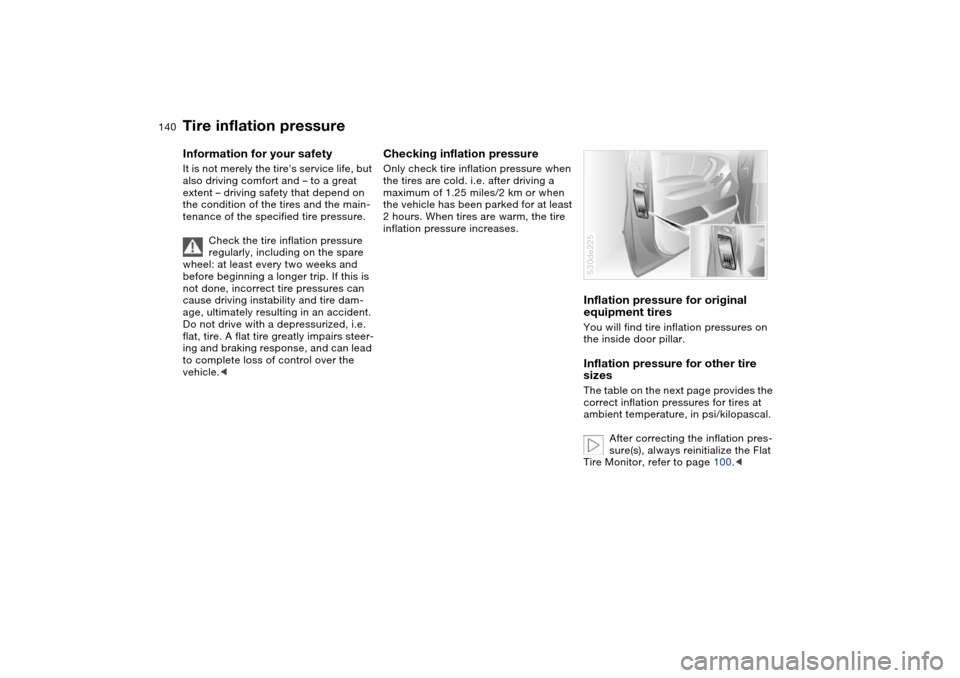
140n
Information for your safety It is not merely the tire's service life, but
also driving comfort and – to a great
extent – driving safety that depend on
the condition of the tires and the main-
tenance of the specified tire pressure.
Check the tire inflation pressure
regularly, including on the spare
wheel: at least every two weeks and
before beginning a longer trip. If this is
not done, incorrect tire pressures can
cause driving instability and tire dam-
age, ultimately resulting in an accident.
Do not drive with a depressurized, i.e.
flat, tire. A flat tire greatly impairs steer-
ing and braking response, and can lead
to complete loss of control over the
vehicle.<
Checking inflation pressureOnly check tire inflation pressure when
the tires are cold. i.e. after driving a
maximum of 1.25 miles/2 km or when
the vehicle has been parked for at least
2 hours. When tires are warm, the tire
inflation pressure increases.
Inflation pressure for original
equipment tiresYou will find tire inflation pressures on
the inside door pillar.Inflation pressure for other tire
sizesThe table on the next page provides the
correct inflation pressures for tires at
ambient temperature, in psi/kilopascal.
After correcting the inflation pres-
sure(s), always reinitialize the Flat
Tire Monitor, refer to page 100.< 530de225
Tire inflation pressure
Page 144 of 200
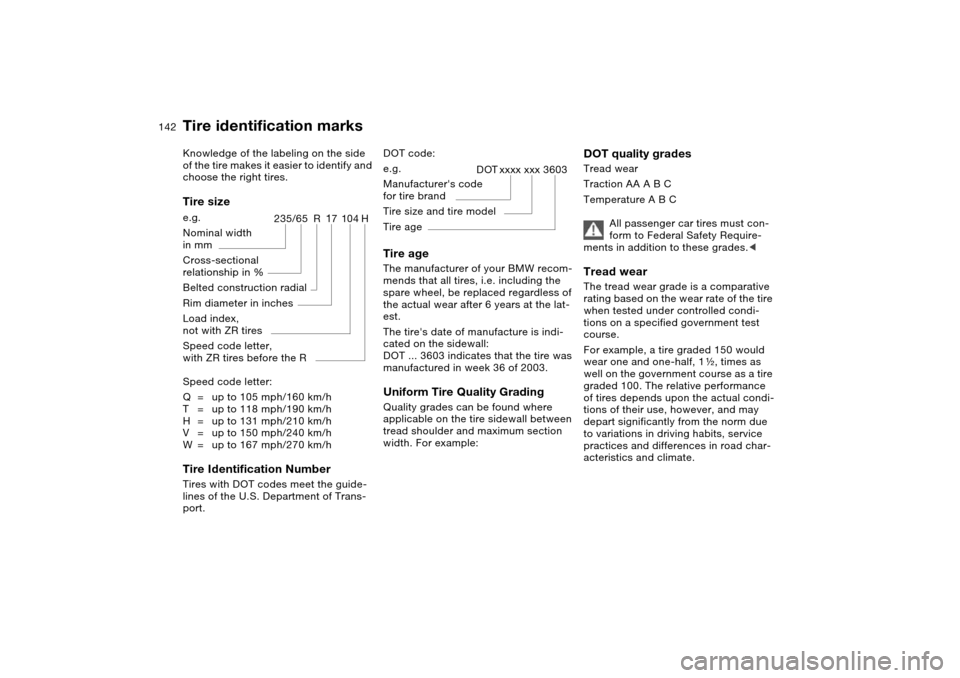
142n
Tire identification marksKnowledge of the labeling on the side
of the tire makes it easier to identify and
choose the right tires.Tire sizeSpeed code letter:
Q=up to 105 mph/160 km/h
T=up to 118 mph/190 km/h
H=up to 131 mph/210 km/h
V=up to 150 mph/240 km/h
W=up to 167 mph/270 km/hTire Identification Number Tires with DOT codes meet the guide-
lines of the U.S. Department of Trans-
port. e.g.
Nominal width
in mm
Cross-sectional
relationship in X
Belted construction radial
Rim diameter in inches
Load index,
not with ZR tires
Speed code letter,
with ZR tires before the R
235/65 R
17104H
DOT code:Tire age The manufacturer of your BMW recom-
mends that all tires, i.e. including the
spare wheel, be replaced regardless of
the actual wear after 6 years at the lat-
est.
The tire's date of manufacture is indi-
cated on the sidewall:
DOT ... 3603 indicates that the tire was
manufactured in week 36 of 2003. Uniform Tire Quality Grading Quality grades can be found where
applicable on the tire sidewall between
tread shoulder and maximum section
width. For example: e.g.
Manufacturer's code
for tire brand
Tire size and tire model
Tire age
DOT xxxx xxx 3603
DOT quality grades Tread wear
Traction AA A B C
Temperature A B C
All passenger car tires must con-
form to Federal Safety Require-
ments in addition to these grades.< Tread wear The tread wear grade is a comparative
rating based on the wear rate of the tire
when tested under controlled condi-
tions on a specified government test
course.
For example, a tire graded 150 would
wear one and one-half, 1g, times as
well on the government course as a tire
graded 100. The relative performance
of tires depends upon the actual condi-
tions of their use, however, and may
depart significantly from the norm due
to variations in driving habits, service
practices and differences in road char-
acteristics and climate.